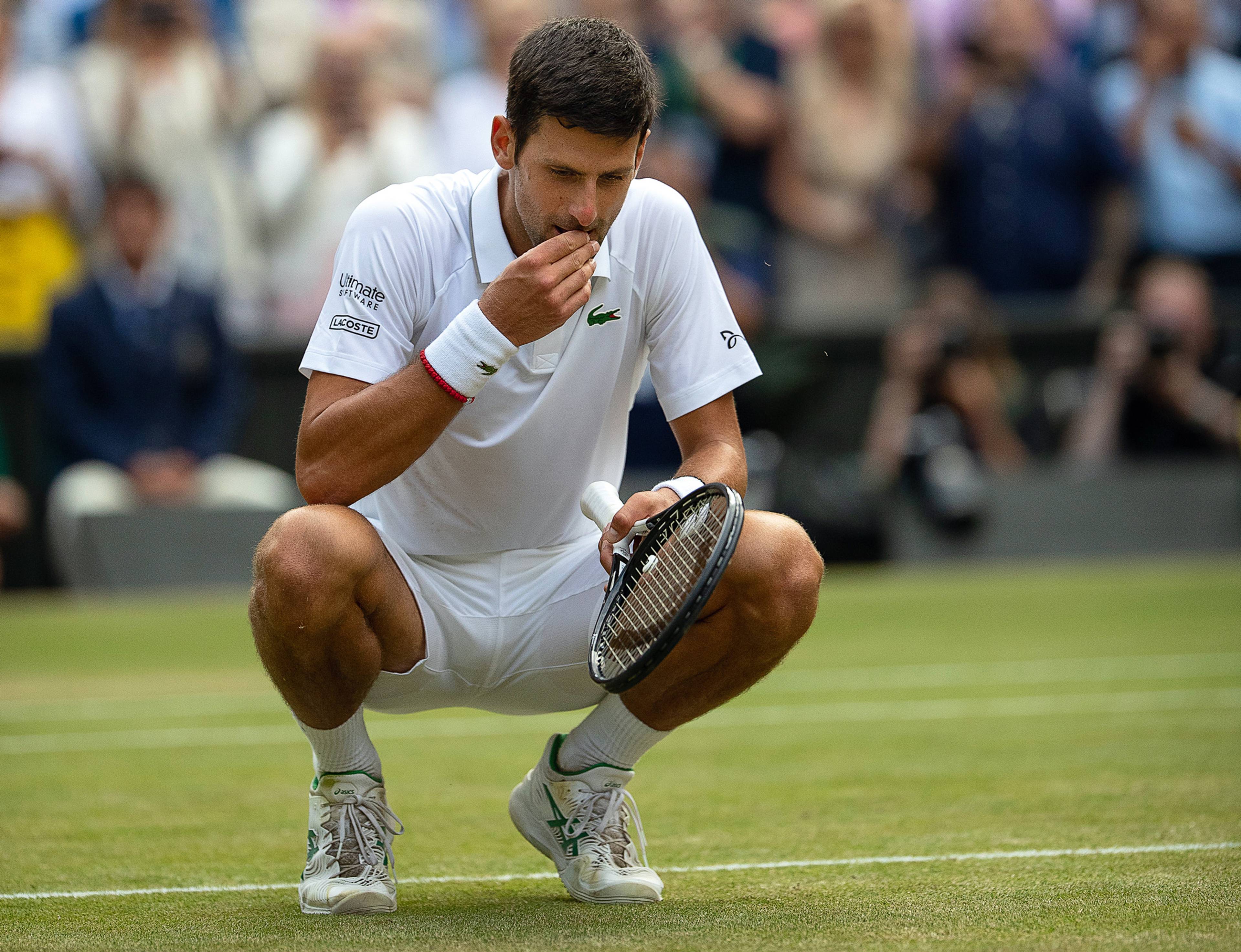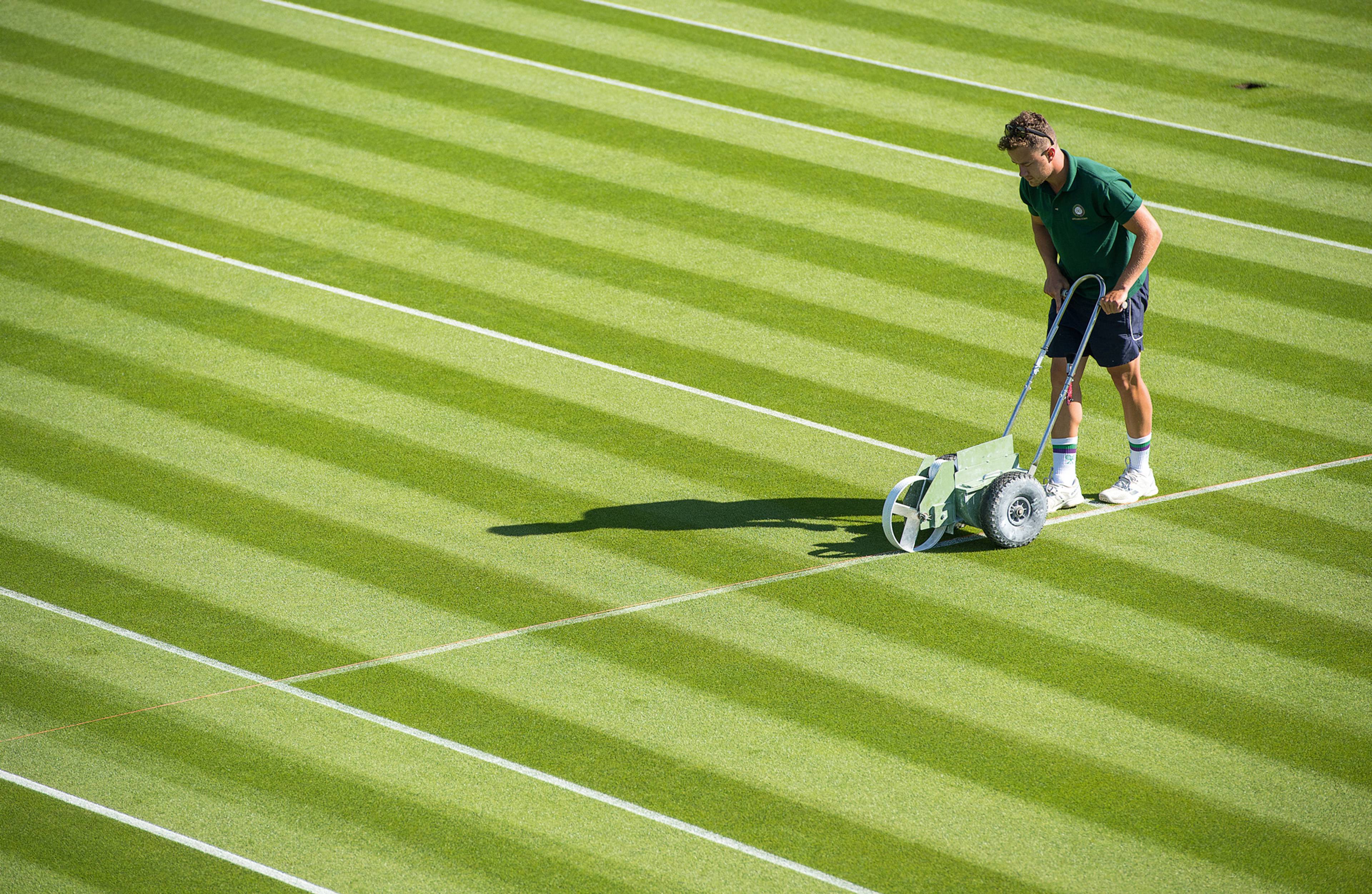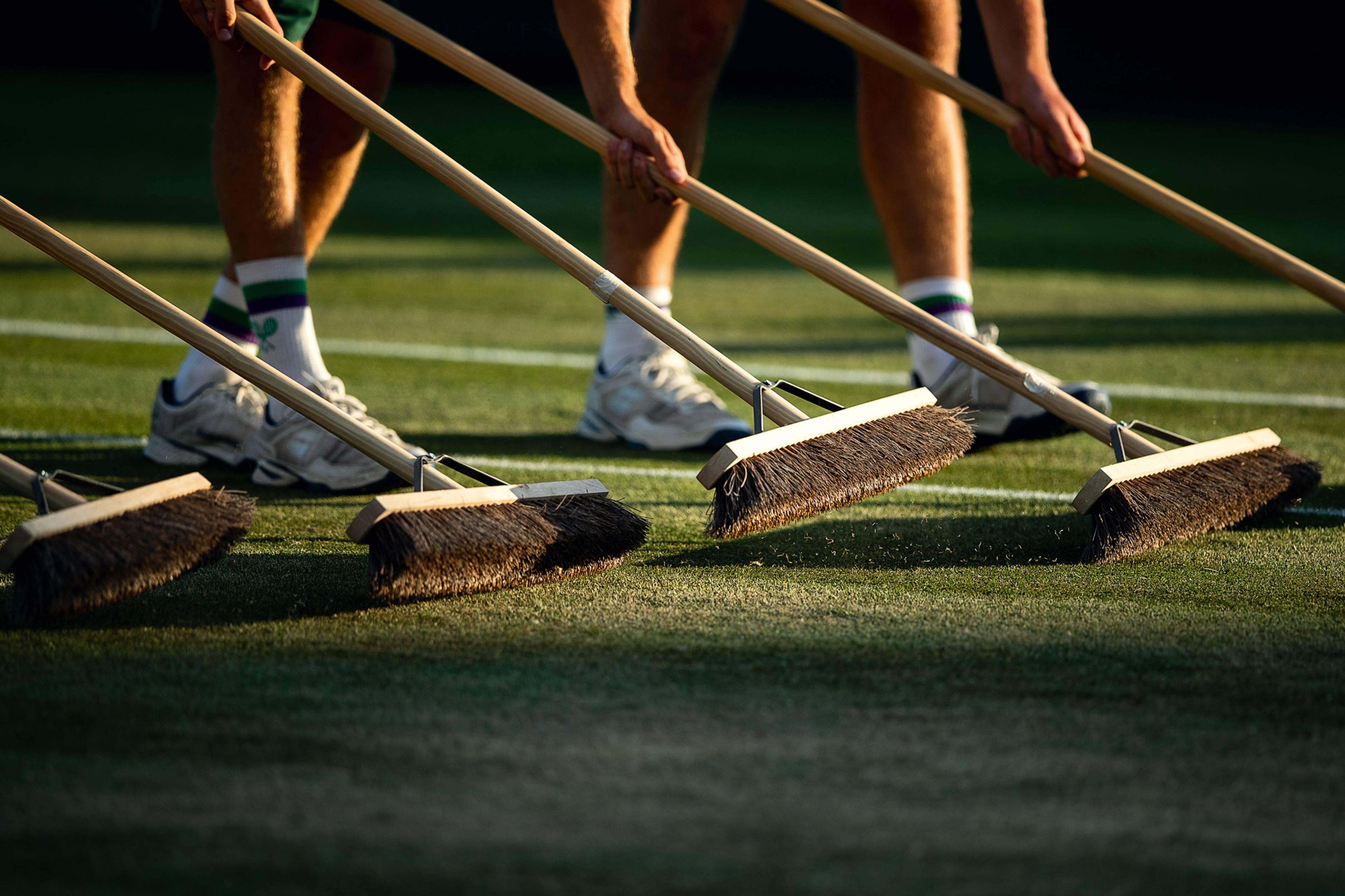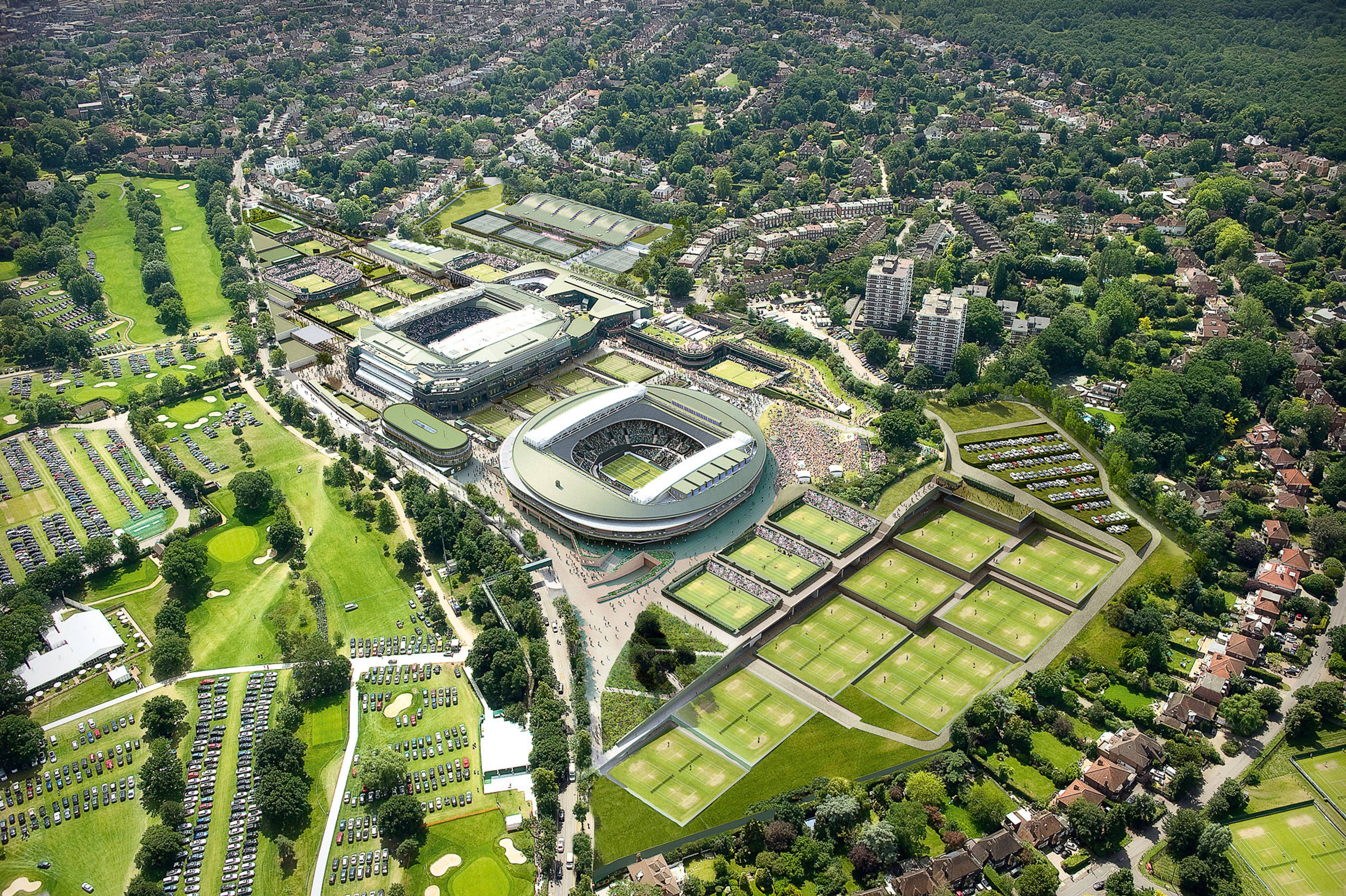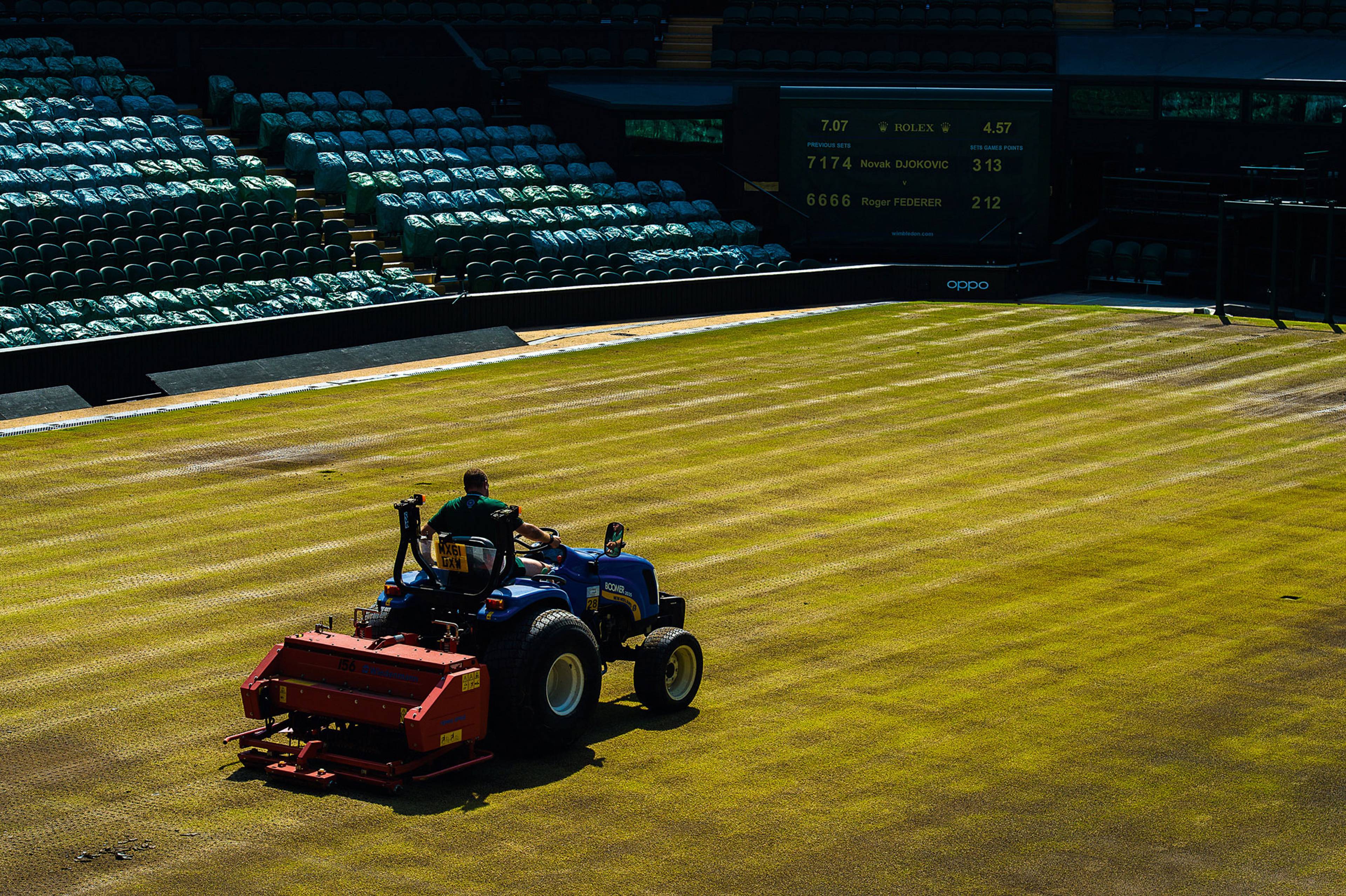Balazs Korchmaros: What is your background and how did you get to your current position?
Neil Stubley: I’ve had two working lives. When I left school, I trained as a chef, but quite early, in my twenties, it was evident that to be a successful chef you had to put in some very long, unsociable hours, weekends, and evenings. So, I didn’t really want to do that. My mother was working at a horticultural college and she said, “Why are you living at home, why don’t you go back to college and train?” I went back to do a general horticulture qualification and one of the modules within the course was about working on turf. I was fortunate enough to get a seasonal position in Wimbledon for the summer. It then turned into a full-time position, and I’ve pretty much worked my way through the ranks. I’ve now been in charge since 2012, just after the London Olympics.
BK: Are you a tennis player yourself?
NS: I do play, but badly. I certainly get put off playing when I see the likes of Andy Murray and Serena [Williams] and Roger [Federer] setting up. Just seeing how easy they make the game look, and how difficult I make the game [Laughter]. I like playing tennis and watching it, but when it’s your job and you work in tennis, you get a little bit desensitized to it and doesn’t really have that awe around it after a while. You’re more concentrating on what’s going on beneath the player’s feet than what they’re doing with their racquet.
BK: Do you like what you do? It must be very demanding.
NS: I’ve been one of the fortunate few to end up in a job that’s very rewarding. You get to showcase your job to millions of people around the globe. On the flip side, it’s also a lot of pressure because the whole world’s looking at your work. We’re all there together on opening night, and I have a very dedicated team around me in the grounds department that have the same sort of focus and vision as I do. They want everything I guess the beauty of our job is that because we’re very much dictated by the elements, the weather, that no two championships are ever the same. One year could be very damp, wet, and cool. Another is dry, hot, and humid, without much rain. You’ve just got to set yourself up for slightly different variables, and you never quite know until a few days before. You can’t really plan too much, and that’s what makes it exciting.
A groundsman marking out lines. He is using a modern-day version of a very fine emulsion paint that gets transferred onto the grass. The lines are freshly marked on the courts every day during The Championships. Photo: AELTC, Thomas Lovelock
Groundstaff brooming the courts to remove any loose debris on the grass, which is then hoovered up to ensure a pristine playing surface. Photo: AELTC, Ben Queenborough
BK: Do you have a daily schedule for everyone on your team, or how do you organize it?
NS: Year-round we have the basics of plant management and grass maintenance. Because we are actually a private members club, people are still using the facilities before and after Wimbledon. Our grass courts open in May and they close in September – it’s quite a long season. After that point, we will still do certain renovations for the courts, put them, as we say, “to bed”, get them ready for the following season. We’ll look at everything that we do – grass species selection to fertilizers, watering regimes, machinery, the mowers we are using, they need to be very sharp, so that when they cut the grass, it cuts it cleanly. This helps it heal quicker rather than tearing it, which leaves the wound open and thus susceptible to disease. We also sort out the different chemicals, if they are the right ones, whether or not we could use them or we lose them because of legislation – all our cultural practices.
BK: After the championships, you basically dig up all of the courts, right?
NS: Slowly, over the course of a few months. Our members and other tournaments still use them. Normally, we’ll take out the main stadiums and start renovating them. Depending on what needs to be done, we’ll either strip off the surface and start from scratch or we have a program where we’ll steam-sterilize the surfaces.
BK: You do the steaming for environmental reasons?
NS: Partly. We don’t want to water the courts too much because we are very conscious of water, fertilizer, chemical, and machinery use, all of which can lead to pollution. With steaming, we might be able to control weeds, pests, and diseases in one hit rather than using three or four different chemicals. It’s still too early to tell, but thus far it’s been very successful. We never know exactly when we’re going to have to steam again. It might be in five years, it could be ten, it’s just that ever-evolving evolution of how we manage our grass courts. There’s nothing quite like Wimbledon, a sporting event held on a natural surface for three weeks of the year, on the same surfaces. If you look at football and rugby, that’s spread over nine months, where you’ll have days or even weeks between matches on a certain pitch. At Wimbledon, it’s ten hours a day, every day, for two weeks.
The best turf managers don’t overcomplicate things. They keep it simple and just make sure to maintain plant health and let the grass survive on its own.
BK: Is there a huge difference between a well-maintained football pitch and a tennis court, according to the quality of grass? Do you use different seed types?
NS: When you go to a sports turf college, as I did, you learn how to manage all surfaces. Once you leave, you’ll need to specialize in a particular sport, whether it be football, golf, tennis, cricket, or whatever. The fundamentals are the same: You’ve got a growing soil or medium. If it’s grass, you’re producing that surface to the best of the ability for the particular sport. They’ve all got their own nuances, and it’s those different criteria that you’ve got to manage.
BK: Is it concrete underneath the court? How do you get the weed, moss, and animals, like worms, out of the ground? Are they still there?
NS: The type of soil we use isn’t really a hospitable environment for most pests to be honest. We do get worms, but not to a great extent. We’re quite a heavy clay loam, most animals like a nice sandy, free-draining soil. The biggest challenge we face is that our grass doesn’t drain very easily. When it does rain, it holds a lot of water, and can stay water-logged. It’s predominately 250 mm of soil on a stone raft and it’s got grass on top, which free drains into the sub-soil. We just shave off the grass every year, re-level, recede, and grow that back through. It’s not rocket science. I think the best turf managers in the world keep it simple and just make sure that you maintain plant health and let the grass survive on its own. It actually makes for a tougher plant if you put it under constant stress and strain for the length of the championships.
BK: And that works, within a cycle of one year? I’m just wondering if there are any negatives of doing that every year?
NS: We do a lot of research into plant breeding and the types of cultivars that we pick. We’ve found a perennial rye grass that becomes very strong and mature by the age of about ten months. Because it’s within that window when we renovate, the plant is coming back into its own again. It has great drought, disease, and heat tolerance, and as long as you’re always replacing sort of sixty or seventy percent of the old grasses each time, then the older grasses just match up with the new ones and get supported.
Wimbledon from above
BK: Why do you think that many tournaments have now moved away from grass? The US Open used to be on grass, the Australian Open as well until 1988. Why did they change, in your view?
NS: I don’t know why the other Grand Slams have gone away from grass. I mean, it does take a lot of maintenance. And I guess sometimes it’s player feedback, if a venue doesn’t want grass anymore because it changes the way that they want to play tennis. I think it bodes well for the Grand Slams if they are on different surfaces. It’s actually a bit more variable for the players, rather than three Slams being on grass and one on clay. Tennis is one of those sports that is unique at the elite level because there are so many different playing surfaces at international standard. Whereas if you look at most other sports, they are played on one surface only, with an occasional second surface. On the tennis circuit, there’s probably thirty or forty different surfaces that can be played on.
BK: In your career, have you witnessed any climate change issues?
NS: Certainly. In the last ten years, we’ve become milder. When you constantly work outside you notice that. The winters in southern England are certainly becoming a lot more clement. We don’t get as much frost and snow, but we get a lot more rain. We do notice as well in the summer that we’re getting more prolonged days of warmth and longer spells without rain. In the last fifteen years, when it rained, it very typically did so lightly, with a persistent, steady fall all day. Now you get more Florida storms, where there is a downpour for about two hours and then all of a sudden it will just clear and the sun comes back out.
The smell of cut grass is very distinctive, like that of freshly baked bread or bacon frying. It reminds you of being a child in the summer.
BK: I was just in a garden and mowing grass, which I makes you somehow really happy. The experience of getting it done and looking at it, whether you do it yourself or not. Why is that? Do you find the same to be true for you, when it’s really nicely done, that looking at it makes people happy?
NS: Yeah, I think it’s one of those things. The smell of cut grass is very distinctive, like that of freshly baked bread or bacon frying. It reminds you of being a child in the summer. When you produce a tennis court and you get players playing on it, it’s something tangible, you can see it, it’s underfoot. Mother Nature can change things very last minute. It keeps you on your toes, and you can never be complacent because once you’ve completed a grass court season, you feel quite happy, but then your mind soon turns to the coming season. You’re constantly thinking of solutions, trying to come up with them before something’s happened. It’s a lot of spent energy.
BK: Wimbledon is a very traditional club. How do you maintain this amazing balance between respecting tradition and still keeping up with the times?
NS: Some things just stand the test of time. If you look at a picture of the 1920s and 30s, let’s say an aerial shot of Wimbledon, things like the wooden posts, the white lines, the stripes of the court, the nets, the net posts, they’re all the same as they are in 2021. The quality of the wood and canvas is probably better now, but essentially it’s still the same colour, it’s still the same feel. You just try to weave that into newer technologies. It’s just a case of making sure you evolve with the sport itself. We look at what we produce as a playing surface in the same way a tennis player would look at themselves: They consider nutrition, staying hydrated. Are they using the best tennis racquet technology, are they using the best strings, have they got the right shoes? The material of their clothes, is it helping them not to overheat and sweat too much. We’ll take all of this into consideration too, but from a different perspective. We think about the plant.
End of grass court season renovations. The tractor has a mechanism that inserts small holes all over the court, allowing air back into the root zone of the grass plant, which has been compacted during the season. Photo: AELTC, Anthony Upton
BK: Do you have a favorite court? Because obviously, Centre Court and the big courts are a bit different than the outside ones. The outside courts look a little bit more like a home garden, not relating so closely to the architecture as the others do.
NS: Well, Centre Court during the crown for the championships is probably the most famous court and tennis stadium in the world. As soon as you see Centre Court Wimbledon, everybody knows where it is, the royal box, people clamor for tickets for Centre Court. What is the one thing that really stands out in the world of tennis? Which tournament? Which stadium? The answer will always be Wimbledon, it will always be Centre Court.
BK: Yeah, but speaking as someone with a background in art, Centre Court is not such a masterpiece of architecture.
NS: No, but it’s got the history!
BK: But the grass is. The grass might be even more important in a Wimbledon setting from an aesthetic point of view than the architecture. I’m wondering how you feel about the colors of Wimbledon, and obviously it’s green and green, and one might say two greens don’t match each other, but they seemingly do, no?
NS: If you don’t like green, you’re in the wrong place if you work at Wimbledon. [Laughter]
The energy of you running around on a grass court is absorbed into the soil. You don’t get really hot playing on it because the plant is absorbing all the heat.
BK: Is green your favorite color?
NS: Yes! One of the beauties of grass court tennis is, because it’s a summer sport, because of the nature of the plant, it absorbs energy and heat. So it’s one of those sports that’s very pleasing to the eye, and when you play it, it’s very nice on the foot because it’s not like concrete that rebounds back into the joints. The energy of you running around on a grass court is absorbed into the soil. You don’t get really hot playing on it because the plant is absorbing all the heat. After twenty- five years of working at Wimbledon, if it’s not green and purple, then it’s not worth having. [Laughter].
BK: What was your best moment at Wimbledon?
NS: I’ve probably got two. In 2012, when we had the Olympics and the championships with only a three-week gap between them. A lot of the research that we’d done in the years leading up to it to be able to recede the baselines, get all the players back, all of the canvasses come down. It almost looked like it was Wimbledon but it wasn’t Wimbledon. Quite a nice experience to see how Wimbledon would look in a parallel universe. The other one is being fortunate enough to see Andy Murray win in 2013 and break that seventy-seven year curse that year after year was becoming more and more of a burden for every British player. I always felt sorry for Tim Henman through his years because you could feel the anxiety and the tension from the British media every time that he was turning up at Wimbledon. You were not only having to compete against the best players of that era – Andre Agassi, Boris Becker, Pete Sampras – but you also had to compete with the expectations of the British media and sixty million residents that wanted you to win. Even after Andy had won (I was in the stadium), he looked like he wasn’t quite sure he had done it, because it had been so long. So, I’d say those were the two highlights for me, for sure.
BK: Is there any person you met who really impressed you? Maybe a tennis player, or a club member?
NS: I’m nicely surprised each year when players turn up at how respectful they are of the championships. You hear all these stories about famous sports people have all this money and live in a bubble. When you actually see them arrive and they’re practicing and there’s no media here, they’re laid-back and relaxed, and they really engage with you. They ask questions about the courts, you can have conversations with them. They’re very approachable and they’re just like you or me. It’s not until the championships start that they get their game face on. If you see them in the weeks leading up in practice, that’s probably just as nice and exciting as the tournament itself because it’s things that not everyone gets to see.
BK: Finally, as the gardener, I have to ask: What’s your feeling about Novak
Djokovic eating your grass?
NS: Well, it’s personal preference. To be fair, I don’t think I would be eating it. If it’s tradition and he feels like he needs to do it because it helps him win, then keep on eating as far as I’m concerned.
BK: You don’t think he should get a code violation? [Laughter]
NS: Oh no! If he eats it at the start of the tournament we might have something to say. But by the end it’s so worn and tired that if he eats another three blades of grass it’s not going to affect us too much, to be fair.
___
This text originally appeared in print in Spike #67 – Sports. You can preview the issue spreads or order your copy in our online shop –


